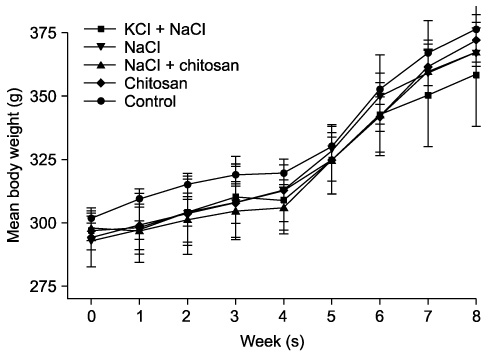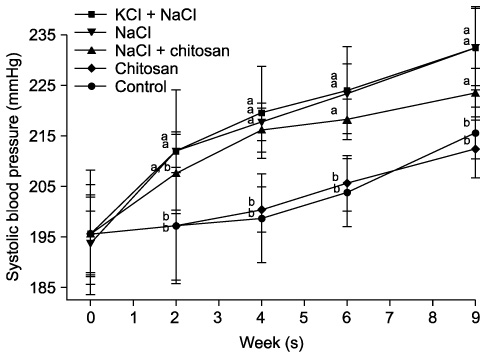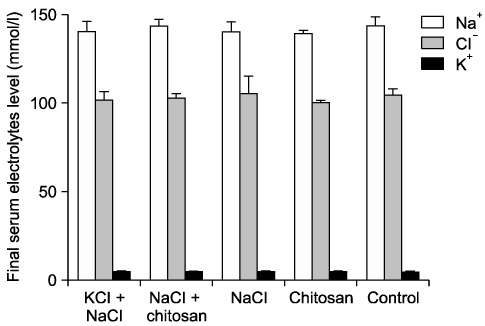J Vet Sci.
2009 Jun;10(2):141-146. 10.4142/jvs.2009.10.2.141.
NaCl plus chitosan as a dietary salt to prevent the development of hypertension in spontaneously hypertensive rats
- Affiliations
-
- 1Laboratory Animal Medicine, and KRF Priority Zoonotic Disease Research Institute, College of Veterinary Medicine, Seoul National University, Seoul 151-742, Korea. pjhak@snu.ac.kr
- 2Biotech , Mokpo 530-370, Korea.
- KMID: 1102970
- DOI: http://doi.org/10.4142/jvs.2009.10.2.141
Abstract
- The effect of NaCl plus 3% chitosan on the systolic blood pressure of spontaneously hypertensive rats (SHR) were evaluated and compared with NaCl plus KCl (NaCl, 49.36% + KCl 49.36%) and chitosan or NaCl treatment alone. In SHR, administration of NaCl plus chitosan (44 mM Na/day) for two months significantly decreased the systolic blood pressure greater than of NaCl plus KCl and NaCl alone. NaCl plus chitosan resulted, though not statistically significant, in decreased urinary Na+ excretion and decreased blood urea nitrogen levels. Urinary creatinine of NaCl plus chitosan was slightly decreased compared to 3 treated groups. Serum electrolytes levels, however, remained unchanged. The combination of NaCl and chitosan may be superior to the conventional use of NaCl plus KCl or NaCl alone in the prevention of hypertension. Even though these supplementary diets have demonstrated potential anti-hypertensive effects in the experimental animal model, further research is needed before any recommendations can be made.
Keyword
MeSH Terms
-
Angiotensin I/blood
Angiotensin II/biosynthesis
Animals
Blood Pressure/*drug effects/physiology
Blood Urea Nitrogen
Body Weight/drug effects
Chitosan/*administration & dosage
Chlorides/blood/urine
Creatinine/urine
Heart/physiology
Histocytochemistry
Hypertension/*prevention & control
Kidney/physiology
Male
Potassium/blood/urine
Potassium Chloride/administration & dosage
Random Allocation
Rats
Rats, Inbred SHR
Sodium/blood/urine
Sodium Chloride, Dietary/*administration & dosage
Systole/drug effects/physiology
Figure
Reference
-
1. Boorman GA, Eustis SL, Elwell MR, Montgomery CA. Jr., MacKenzie WF. Pathology of the Fischer Rat. 1990. San Diego: Academic Press;132–137. 146–151.2. Chen Q, Xuan G, Fu M, He G, Wang W, Zhang H, Ruan H. Effect of angiotensin I-converting enzyme inhibitory peptide from rice dregs protein on antihypertensive activity in spontaneously hypertensive rats. Asia Pac J Clin Nutr. 2007. 16:Suppl 1. 281–285.3. Chrysant GS, Bakir S, Oparil S. Dietary salt reduction in hypertension--what is the evidence and why is it still controversial? Prog Cardiovasc Dis. 1999. 42:23–38.
Article4. de Wardener HE, He FJ, MacGregor GA. Plasma sodium and hypertension. Kidney Int. 2004. 66:2454–2466.
Article5. Deshmukh M, Lee HW, McFarlane SI, Whaley-Connell A. Antihypertensive medications and their effects on lipid metabolism. Curr Diab Rep. 2008. 8:214–220.
Article6. Fukuda S, Tsuchikura S, Iida H. Age-related changes in blood pressure, hematological values, concentrations of serum biochemical constituents and weights of organs in the SHR/Izm, SHRSP/Izm and WKY/Izm. Exp Anim. 2004. 53:67–72.
Article7. Hutchinson JS, Mendelsohn FA, Doyle AE. Blood pressure responses of conscious normotensive and spontaneously hypertensive rats to intracerebroventricular and peripheral administration of captopril. Hypertension. 1980. 2:546–550.
Article8. Je JY, Park PJ, Kim B, Kim SK. Antihypertensive activity of chitin derivatives. Biopolymers. 2006. 83:250–254.
Article9. Je JY, Park JY, Jung WK, Park PJ, Kim SK. Isolation of angiotensin I converting enzyme (ACE) inhibitor from fermented oyster sauce, Crassostrea gigas. Food Chem. 2005. 90:809–814.
Article10. Jenei Z, Páll D, Katona E, Kakuk G, Polgár P. The epidemiology of hypertension and its associated risk factors in the city of Debrecen, Hungary. Public Health. 2002. 116:138–144.
Article11. Jo I, Ahn Y, Lee J, Shin KR, Lee HK, Shin C. Prevalence, awareness, treatment, control and risk factors of hypertension in Korea: the Ansan study. J Hypertens. 2001. 19:1523–1532.
Article12. Kannel WB. Blood pressure as a cardiovascular risk factor: prevention and treatment. JAMA. 1996. 275:1571–1576.
Article13. Kim D, Yokozawa T, Hattori M, Kadota S, Namba T. Effects of aqueous extracts of Apocynum venetum leaves on spontaneously hypertensive, renal hypertensive and NaCl-fed-hypertensive rats. J Ethnopharmacol. 2000. 72:53–59.
Article14. Kimura Y, Okuda H. Prevention by chitosan of myelotoxicity, gastrointestinal toxicity and immunocompetent organic toxicity induced by 5-fluorouracil without loss of antitumor activity in mice. Jpn J Cancer Res. 1999. 90:765–774.
Article15. Koide SS. Chitin-chitosan: Properties, benefits and risks. Nutr Res. 1998. 18:1091–1101.
Article16. Koike H, Ito K, Miyamoto M, Nishino H. Effects of long-term blockade of angiotensin converting enzyme with captopril (SQ14,225) on hemodynamics and circulating blood volume in SHR. Hypertension. 1980. 2:299–303.
Article17. Majima M, Hayashi I, Inamura N, Fujita T, Ogino M. A nonpeptide mimic of bradykinin blunts the development of hypertension in young spontaneously hypertensive rats. Hypertension. 2000. 35:437–442.
Article18. Mélançon S, Bachelard H, Badeau M, Bourgoin F, Pitre M, Larivière R, Nadeau A. Effects of high-sucrose feeding on insulin resistance and hemodynamic responses to insulin in spontaneously hypertensive rats. Am J Physiol Heart Circ Physiol. 2006. 290:H2571–H2581.
Article19. Mhurchu CN, Dunshea-Mooij C, Bennett D, Rodgers A. Effect of chitosan on weight loss in overweight and obese individuals: a systematic review of randomized controlled trials. Obes Rev. 2005. 6:35–42.
Article20. Muntner P, Krousel-Wood M, Hyre AD, Stanley E, Cushman WC, Cutler JA, Piller LB, Goforth GA, Whelton PK. Antihypertensive prescriptions for newly treated patients before and after the main antihypertensive and lipid-lowering treatment to prevent heart attack trial results and seventh report of the joint national committee on prevention, detection, evaluation, and treatment of high blood pressure guidelines. Hypertension. 2009. 53:617–623.
Article21. Nakamura S, Averill DB, Chappell MC, Diz DI, Brosnihan KB, Ferrario CM. Angiotensin receptors contribute to blood pressure homeostasis in salt-depleted SHR. Am J Physiol Regul Integr Comp Physiol. 2003. 284:R164–R173.22. Singh RB, Suh IL, Singh VP, Chaithiraphan S, Laothavorn P, Sy RG, Babilonia NA, Rahman AR, Sheikh S, Tomlinson B, Sarraf-Zadigan N. Hypertension and stroke in Asia: prevalence, control and strategies in developing countries for prevention. J Hum Hypertens. 2000. 14:749–763.
Article23. Tanaka M, Schmidlin O, Yi SL, Bollen AW, Morris RC Jr. Genetically determined chloride-sensitive hypertension and stroke. Proc Natl Acad Sci USA. 1997. 94:14748–14752.24. Terragno DA, Crowshaw K, Terragno NA, McGiff JC. Prostaglandin synthesis by bovine mesenteric arteries and veins. Circ Res. 1975. 36:Suppl 1. 76–80.
Article25. Williams B, Poulter NR, Brown MJ, Davis M, McInnes GT, Potter JF, Sever PS, Thom S McG. Guidelines for management of hypertension: report of the fourth working party of the British Hypertension Society, 2004-BHS IV. J Hum Hypertens. 2004. 18:139–185.
Article26. Wu DM, Pai L, Chu NF, Sung PK, Lee MS, Tsai JT, Hsu LL, Lee MC, Sun CA. Prevalence and clustering of cardiovascular risk factors among healthy adults in a Chinese population: the MJ Health Screening Center Study in Taiwan. Int J Obes Relat Metab Disord. 2001. 25:1189–1195.
Article27. Yang HY, Yang SC, Chen JR, Tzeng YH, Han BC. Soyabean protein hydrolysate prevents the development of hypertension in spontaneously hypertensive rats. Br J Nutr. 2004. 92:507–512.
Article28. Zhu YZ, Wang ZJ, Zhu YC, Zhang L, Oakley RM, Chung CW, Lim KW, Lee HS, Ozoux ML, Linz W, Böhm M, Kostenis E. Urotensin II causes fatal circulatory collapse in anesthesized monkeys in vivo: a "vasoconstrictor" with a unique hemodynamic profile. Am J Physiol Heart Circ Physiol. 2004. 286:H830–H836.
Article
- Full Text Links
- Actions
-
Cited
- CITED
-
- Close
- Share
- Similar articles
-
- Role of tyrosine kinases in vascular contraction in deoxycorticosterone acetate-salt hypertensive rats
- Pressor Responses to Intracerebroventricular Infusion of Hypertonic NaCl in Renal Hypertensive Rats
- Time-Related Alterations of Endogenous Ouabain in DOCA-Salt Hypertensive Rats
- Effects of Centrally Administered Losartan on Deoxycorticosterone-salt Hypertension Rats
- Effect of Ginseng on the Blood Pressure and Lipid Metabolism, during Development of Hypertension in Spontaneously Hypertensive Rat







